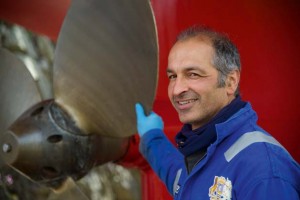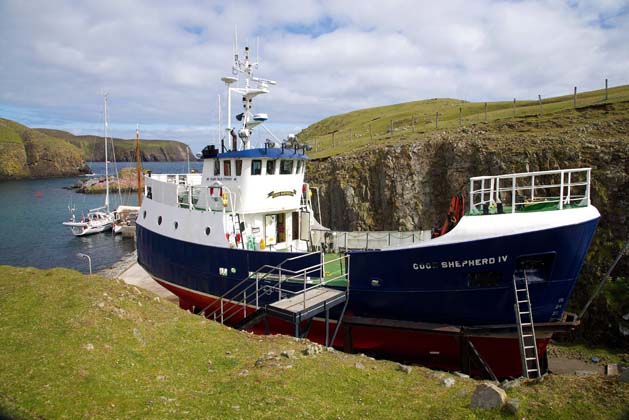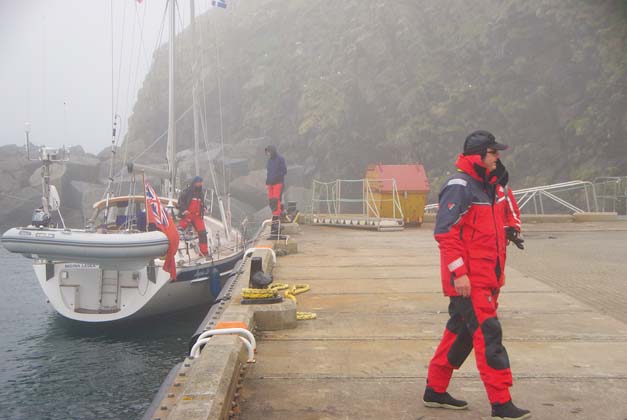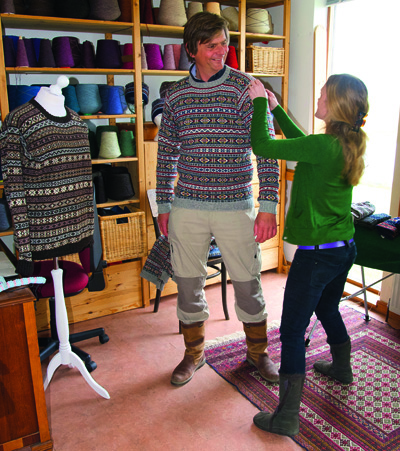Heading for the tiny, remote Scottish island of Fair Isle to pick up his hand-knitted sweater, Leon Schulz found it much like living on a boat – no wonder he felt so at home
One man, many jobs
Deryk, who as well as looking after his sheep, working on the ferry and being part of the fire brigade, also acts as the wind farm engineer, explains that he has been trying to get the wind generator back in order for quite some time now. The problem is that it is so old that spare parts have not been available for decades and so every item has to be rebuilt by the innovative people of Fair Isle.
“Diesel power is so expensive, so I really have to get this mill going soon again,” Deryk said while he was washing off the hull of the Good Shepherd.
The ferry is pulled ashore each night as it would be too dangerous to leave her in the water in case it blows a gale, which happens more often than not. I think this says a lot about life amidst the relentlessly harsh climate of Fair Isle.
Deryk continued to tell us about his home, explaining that the island was once owned by Dr George Waterston, the eminent ornithologist, and was acquired by the National Trust for Scotland in 1954, shortly after the renowned bird observatory was established. Such is Fair Isle’s reputation for recording birds that bird watchers and lovers come from all over the world.
Hollie and Deryk met at university in Newcastle and they were in their late twenties when they decided to work as ‘birdies’ for a year or two at the observatory here. That was 16 years ago. “As long as you are flexible, resilient and resourceful you can have a great life here with a very low cost of living and the children living close to nature in a wonderful island community,” Deryk explained while I recognised more and more similarities to families living aboard their boats for the same reasons.
 He has no thoughts of leaving. “Who would then look after the wind generator, keep Good Shepherd in mint condition, work as a fireman and control the airspace?” This reminded him that he had to leave immediately for the airstrip to “take down the plane from Shetland,” as he described it. As his four-wheel drive car was already rolling he called out: “Did I tell you that I am the relief airfield controller on the island as well?”
He has no thoughts of leaving. “Who would then look after the wind generator, keep Good Shepherd in mint condition, work as a fireman and control the airspace?” This reminded him that he had to leave immediately for the airstrip to “take down the plane from Shetland,” as he described it. As his four-wheel drive car was already rolling he called out: “Did I tell you that I am the relief airfield controller on the island as well?”
And off he drove up the top of the green hill where I could barely make out the orange windsock. Soon I could hear the propeller noise of a small aircraft winding itself down toward the green grass of Fair Isle. It’s a busy place, after all, I thought, smiling to myself.
Wool and birds
“Sheep, wool and birds is what unites the island, if you don’t work remotely via internet,” Hollie explained.
She is one of the dozen official knitters on the island. “I do 20 sweaters during the winters plus hats, gloves and bags. During summers I am so busy with all my other jobs: I work remotely via the internet for a small nature tour company, Shetland Nature, organising holiday tours and I plan the cruise ship visits to the island as well. Also I am the secretary of the school and I look after all the sheep, of course!”
The thought sprang to my mind that this could be an ideal place for a young family who wish to live on small costs with their children growing up in a safe and child-friendly natural environment, with the parents working internationally by means of the internet. It is a dream that many people with busy and stressed lives hanker after.
Just like living on a boat, Hollie’s work is planned according to the weather. When there are three days of no rain, all the children would be gathered so that Hollie and her husband could paint the house. Three consecutive days without rain had yet to happen that summer and if it didn’t happen this year at all, there would always be another year, Hollie reckoned.
What cannot be postponed, however, is the sheep shearing. Again, all the children are gathered together and the entire island helps to harvest the valuable wool by clipping the sheep by hand, as it has always been done. The wool is sent to Shetland where it is spun and dyed to the beautiful Shetland wool we know. Back on Fair Isle the treated wool is turned into the famous sweaters bearing the island’s name. A true Fair Isle has no more than one or two colours on each row with an average of four colours used throughout. A block of pattern is never repeated in the same garment. Electric machines are not used in any part of the process and the sweaters cannot be compared to the cheap imitations found in stores around the world.
Down the years
The Fair Isle patterns have a long history. In former days it was important to know to which island a drowned fisherman was to be brought back to if a body was found floating in the sea, so each family had its own unique patterns.
Hollie pointed to the floor in her house where a beautiful carpet from Afghanistan was lying decoratively and which somehow had found its way around the globe to Fair Isle.
“In the olden days, islanders used to trade fresh food, water and the famous Fair Isle sweaters with sailors making landfall on Fair Isle on their onward journeys. In return, the islanders received goods they carried on board, such as, maybe, this carpet from Afghanistan.
“Patterns could also have originated from the Vikings who were settling the Orkney and Shetland islands for hundreds of years. Nobody knows.”
When comparing the old carpet from Afghanistan with the traditional patterns used by Hollie in her knitting, I wondered who was inspired by whom. The patterns on the carpet and Hollie’s knitting looked very similar; both very old and traditional.
I tried on my new Fair Isle sweater – the first true tailor-made piece of clothing I have ever owned. It fitted snugly and I really liked the traditional pattern, checking carefully that no more than two colours had been used in each row and that no block of pattern had been repeated throughout the garment.
Cyndy from Australia, one of my charter guests aboard Regina Laska, tried on a hat and ordered a sweater for herself as well, number 19 out of 20 to be made during the following winter to be ready the next summer. I asked Cyndy if she would return next year to pick it up, but she just laughed: “For an Aussie, it is too cold to sail to Fair Isle two years in a row!” She preferred her new Fair Isle to be sent to her by post.
What Cyndy possibly did not know, yet, is that a Fair Isle sweater is not only stylish and will never go out of fashion, but is also knitted for the cold winter days on Fair Isle and keeps you truly cosy.
I decided I would definitely return again – especially when I feel I need to experience the warmth of the people and its original Fair Isles.
In the meantime the pattern on my sweater will turn my thoughts back to Burkle House, Fair Isle, where Hollie once sat during stormy dark winter nights, knitting it. Beguiling and starkly beautiful, it is a fair isle, indeed.
Leon Schulz sails his Hallberg-Rassy 46 Regina Laska six months of the year, offering RYA sail training from Start Yachting to Yachtmaster Prep Courses, specialising in cruising to remote places in safety, comfort and style. www.reginasailing.com








